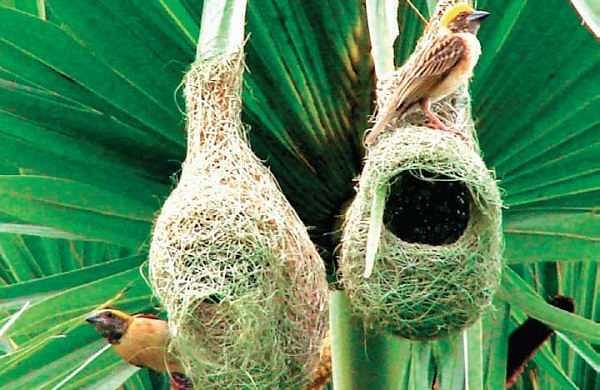Berhampur: Bird watchers are delighted as they have spotted several newly-sprung, intricately-woven nests of the baya weaver in different trees near the mouth of the Rushikulya river in Odisha’s Ganjam district.
The helmet-shaped nests have been seen hanging from trees, including a palm tree. The nests are the indefatigable effort of the baya weavers, an endangered bird species, to protect the family from predators.
“We have found over 100 such nests in a single palm tree at a farm field in Subalaya,” said Rabindra Nath Sahu, the honorary wildlife warden for Ganjam.
He and Magata Behera — one of the members of the Rushikulya Sea Turtle Protection Committee in Puruna Bandha have recently sighted the nests while they conducted a survey on the nests of the baya weaver.
Besides Subalaya, they have also found the nests in at least 10 trees near Kantiagada near the river mouth — — the famous rookery for the olive ridley turtles.
The nests were also spotted at the Ganjam railway station and near the wetlands in different areas in Chhatrapur, Beguniapada, Rangeilunda and Kabisurya Nagar blocks. The total number of nests is around 2,000, said Sahu.
The sighting of such a large number of nests in the district is a good sign at a time the population of the baya weavers is declining in other parts of the country, Berhampur Divisional Forest Officer (DFO) Amlan Nayak said.
“Even electric wires are preferred by them for nest-building by these birds as I have seen in some villages in Patrapur area,” the DFO said.
They might have selected the electric wire as the safer place for the nests by the fact that predators like snakes cannot access them, according to Nayak.
Ornithologists said the male baya weavers make a nest with super craftsmanship to secure it from predators and water with sufficient heat shield.
The female inspects the nest and if it finds it to be good enough, it accepts the advances of the male bird. A female bird gives two to four eggs in the nest, while its male counterpart protects the eggs.
Earlier, about a decade ago, a number of nests were found hanging from the trees in different places. But now, their number was dwindling rapidly and it was hard to find such nests, Behera said.
“This year, however, we have seen a sudden spurt of these nests in different areas,” Behera said.
“We will take steps to protect the trees where the baya weavers’ nest,” the DFO said.
